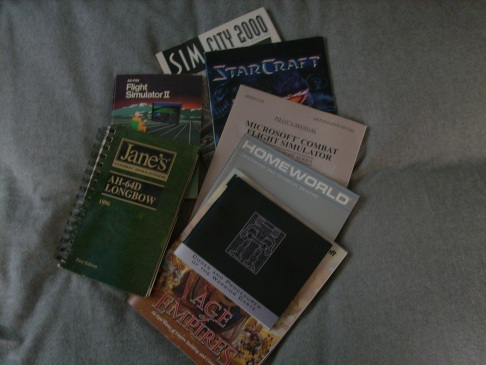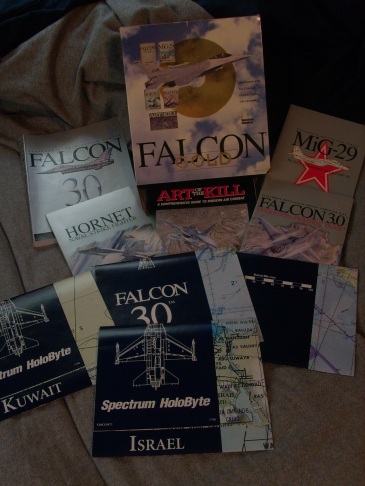I was inspired by a post over on Kotaku mentioning the fact that UbiSoft was discontinuing the use of printed manuals and giving a few examples of the game manuals of old, and why they were so awesome. I have to admit I’ve completely forgotten how great game manuals used to be, so I immediately went into my closet and dug out my tonnes of game manuals (I’ve never thrown one out, only lost a few). Wow, I mean – wow! How could I have forgotten how much work and effort used to go into these things? I mean I’m holding books in my hands by today’s game manual standards. The new Cassava bingo sites 2018 offer a great user friendly interface and probably doesn’t have nor need a manual. These are freaking tomes. Here’s a selection of my favorites, and why I like them so.
I apologize for all the crappy photos 😛

SimCity 2000 (140pg), Age of Empires (126pg), Microsoft Combat Flight Simulator (199pg)
All of these manuals are common enough instruction-wise as they mainly contain text pertaining to how to play the game. However they also contain a lot of breakout boxes/sidebars/sections that reside off to the side/edge of the page and contain historical/real-world information relating to the current topic the manual is covering. For example we have a page from the SC2K guide here that discusses zoning systems and changes, noting “This is how most municipal planning and zoning systems are supposed to work: When meaningful changes to a city’s makeup are suggested, planners select options for review and assemble reports for discussion. If these discussions become controversial, the reports are analyzed by elected (political) officials and a decision is made, in theory, based upon a thorough study of options, facts and findings.”
The Age of Empires manual had far more of these tidbits on the sides of practically every other page throughout the first 65 pages of the manual, the part that explained how to play the game. The reason there weren’t any more beyond that is because pages 66 – 106 provided detailed historical information on every culture featured in the game (the rest of the manual were unit trees and stats, index, credits, etc). This information had no direct effect on the gameplay, other than to give you ideas of how that culture evolved to get a better idea of how to utilize their unique abilities within the game. The pages also included cool sketch art, like this page who’s sidebar reads: “The demands of business and trade eventually led to the development of money, which served as a medium of exchange, a storehouse of value and a standard of value. Silver rings or bars are thought to have been used as money in ancient Iraq before 2000 BC. The first coins were made of Electrum, a naturally-occurring and easily malleable alloy of gold and silver.”
The Combat Flight Simulator manual contained even more educational material than Age of Empires. Because it was all based on real events and real physics, the game manual was pretty much a guide of how to fly and perform combat maneuvers in WWII-era aircraft along with a history of famous WWII figures, missions and campaigns. Although they could have done a better job with the cover design and binding, they did a pretty nice job of making it like a top-secret brief folder that couriers would carry around during the war. Being able to learn how to play a game and learn about history at the same time is pretty neat.
Homeworld (115pg)
This has to be my favorite game guide ever. It’s just the whole package: the manual is bound with a fold crease on the cover (like trade-paperback comics) to prevent you from destroying the binding; the pages are glossy and sturdy; the layout of the manual is so nice and clean and well-done with superb page design; the content describing the history of the races in the game is great fictional reading.
The first 39 pages of the manual are reserved for the history of the clans and the technical details behind the ships you’re controlling in the game. The rest of the manual delves deep into the gameplay and controls and isn’t afraid to make you turn it sideways for a landscape layout of some of the tech trees and interfaces.
I should give the Homeworld: Cataclysm guide an honorable mention, but it was more like a regular game manual than a glossed-out technical briefing book.
StarCraft (95pg)
The StarCraft manual is another great fictional-material guide, with histories for all three of the game’s races laid out in detail and accompanied by some amazing original artwork. It’s also all-business in its design, not wasting time going into strategy or any real detail into how to play the game since it has a great campaign that slowly introduces you to various tactics and abilities as you progress.
I remember taking the StarCraft manual to bed with me to read before going to sleep. What game manual these days do you do that with??
Jane’s Combat Simulations AH-64D Longbow
The Jane’s Combat games were all about one thing, and one thing only: utter realism. They pushed CPUs of the time as far as possible to achieve the most realistic simulations you could ask for from a computer. I actually never really played this game because my computer couldn’t run it!! But the manual didn’t even need the game to be interesting to a military buff like myself, since it included all kinds of real-world information from combat tactics to weapon emplacement/aircraft/vehicle statistical information. After all, this is the business that Jane’s is in.
I actually wish Jane’s would team up with software developers again for some more simulation games. It’s sad to see this genre of games slowly dying off as consumer computers continue to grow more capable of realistic simulation.
This manual uses an index organization but I would guesstimate the page count at around 250.
Flight Simulator II
There is nothing special about this manual besides the fact that it could possibly be considered a collectible item these days and it was my first experience with flight simulators that originally sparked my interest in flying planes. Huzzah!
MechWarrior 2 (72pg)
The neat-o thing about this game manual is that practically every page has hand-scribbled notes accompanying the actual text of the manual, sometimes sketches of vehicles and buildings as well. The extra cool thing about all these notes however is that they contained any keyboard commands that were needed to carry out the actions that the manual was describing. Nowhere in the manual does it say in the text anything like “press F1 to enter the weapon inventory screen”. Instead it will describe how to use the weapon inventory screen and in the margins will be scribbled “Access to inventory screen: F1”
Recently, the Assassin’s Creed 1 game manual also has similar notations in the margins – which is kind of ironic considering AC1 was published by UbiSoft 🙂
Falcon Gold

This box set comprised the entire Falcon series for 3.0, which was 4 games plus a special “Art of the Kill” guidebook and video that took you through various flight combat techniques. The “Art of the Kill” book wasn’t even a manual itself – well I mean it wasn’t a manual to any of the games. It was a manual on how to perform various air combat maneuvers in the F-16 Fighting Falcon. Then there were the sectional charts for the various game’s flying areas as well.
Game Manual Kin: Tech Tree Charts
Finally, let’s not forget another aspect of game manuals that are also practically gone forever: the tech tree chart. This applied to strategy games and they were handy fold-outs that let you reference what unit or building had to be constructed prior to constructing another unit or building. Some, like the StarCraft tech tree, were small and easy to reference. The StarCraft one could be folded a variety of ways so you would be able to see both the unit and building trees. Others, like the Empire Earth tech tree, were so massive they needed a freaking poster to accommodate everything.
Farewell, game manuals of old
Yea, game manuals were pretty awesome at one point. They actually added value to the purchase of the game, instead of being a couple pages of text and images you kinda skimmed through once and then tossed aside never to look at again. It’s sad to see them go, but if I ever need some night-time reading material I can always refresh my history of Protoss ascendancy, or re-learn some aspects of WWII, or re-discover the ancient origins of the Kharak.

Tweets that mention My favorite game manuals -- Topsy.com // Apr 22, 2010 at 10:43 pm
[…] This post was mentioned on Twitter by Drew Sikora. Drew Sikora said: in which I talk and photograph (poorly I admit) my favorite game manuals of old that I proudly own: http://ping.fm/gonrn […]